inflation pressure TOYOTA TACOMA 2012 Owners Manual (in English)
[x] Cancel search | Manufacturer: TOYOTA, Model Year: 2012, Model line: TACOMA, Model: TOYOTA TACOMA 2012Pages: 628, PDF Size: 12.11 MB
Page 5 of 628

1
2
3
4
5
6
7
5
4-3. Do-it-yourself maintenanceDo-it-yourself service precautions ....................... 430
Hood ................................... 434
Engine compartment ........... 436
Tires .................................... 452
Tire inflation pressure ......... 461
Wheels ................................ 466
Air conditioning filter............ 469
Wireless remote control battery ............................... 472
Checking and replacing fuses ................................. 474
Light bulbs........................... 484
5-1. Essential information Emergency flashers ............ 496
If your vehicle needs to be towed ........................... 497
If you think something is wrong ................................ 503
Fuel pump shut off system .............................. 504 5-2. Steps to take in an emergency
If a warning light turns on or a warning buzzer
sounds... .......................... 505
If you have a flat tire ........... 515
If the engine will not start.... 532
If the shift lever cannot be shifted from P (vehicles
with an automatic
transmission) .................... 533
If you lose your keys........... 534
If the vehicle battery is discharged........................ 535
If your vehicle overheats .... 539
If the vehicle becomes stuck ................................. 542
If your vehicle has to be stopped in
an emergency .................. 544
6-1. Specifications Maintenance data (fuel, oil level, etc.) ........... 548
Fuel information.................. 569
Tire information .................. 572
6-2. Customization Customizable features........ 583
Items to initialize ................. 587
5When trouble arises
6Vehicle specifications
Page 9 of 628
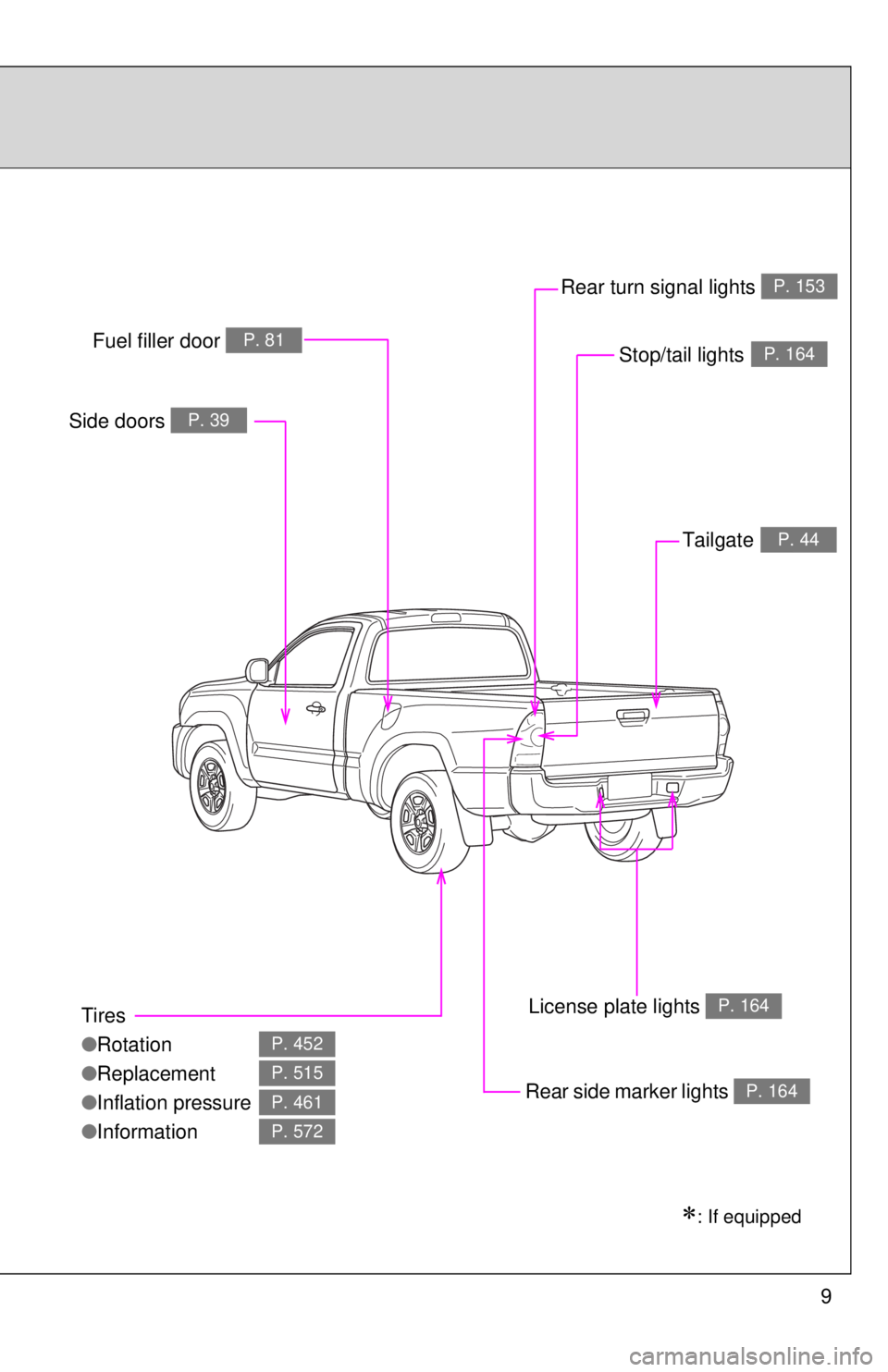
9
Tires
●Rotation
● Replacement
● Inflation pressure
● Information
P. 452
P. 515
P. 461
P. 572
Fuel filler door P. 81
Rear turn signal lights P. 153
Rear side marker lightsP. 164
Side doors P. 39
Stop/tail lightsP. 164
TailgateP. 44
License plate lights P. 164
: If equipped
Page 11 of 628
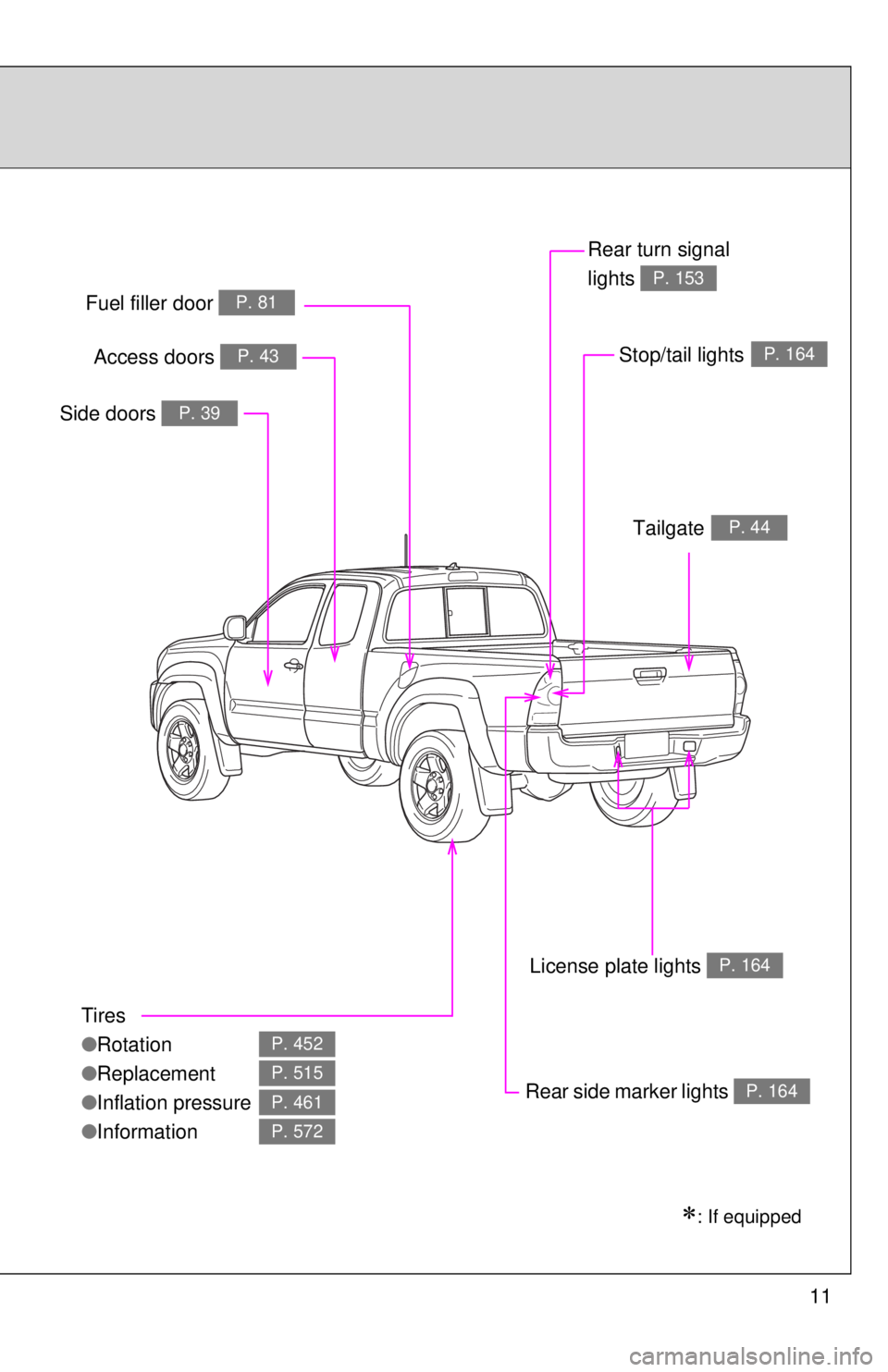
11
Tires
●Rotation
● Replacement
● Inflation pressure
● Information
P. 452
P. 515
P. 461
P. 572
Fuel filler door P. 81
Rear turn signal
lights
P. 153
Rear side marker lightsP. 164
Side doors P. 39
: If equipped
Stop/tail lightsP. 164
TailgateP. 44
License plate lights P. 164
Access doors P. 43
Page 13 of 628
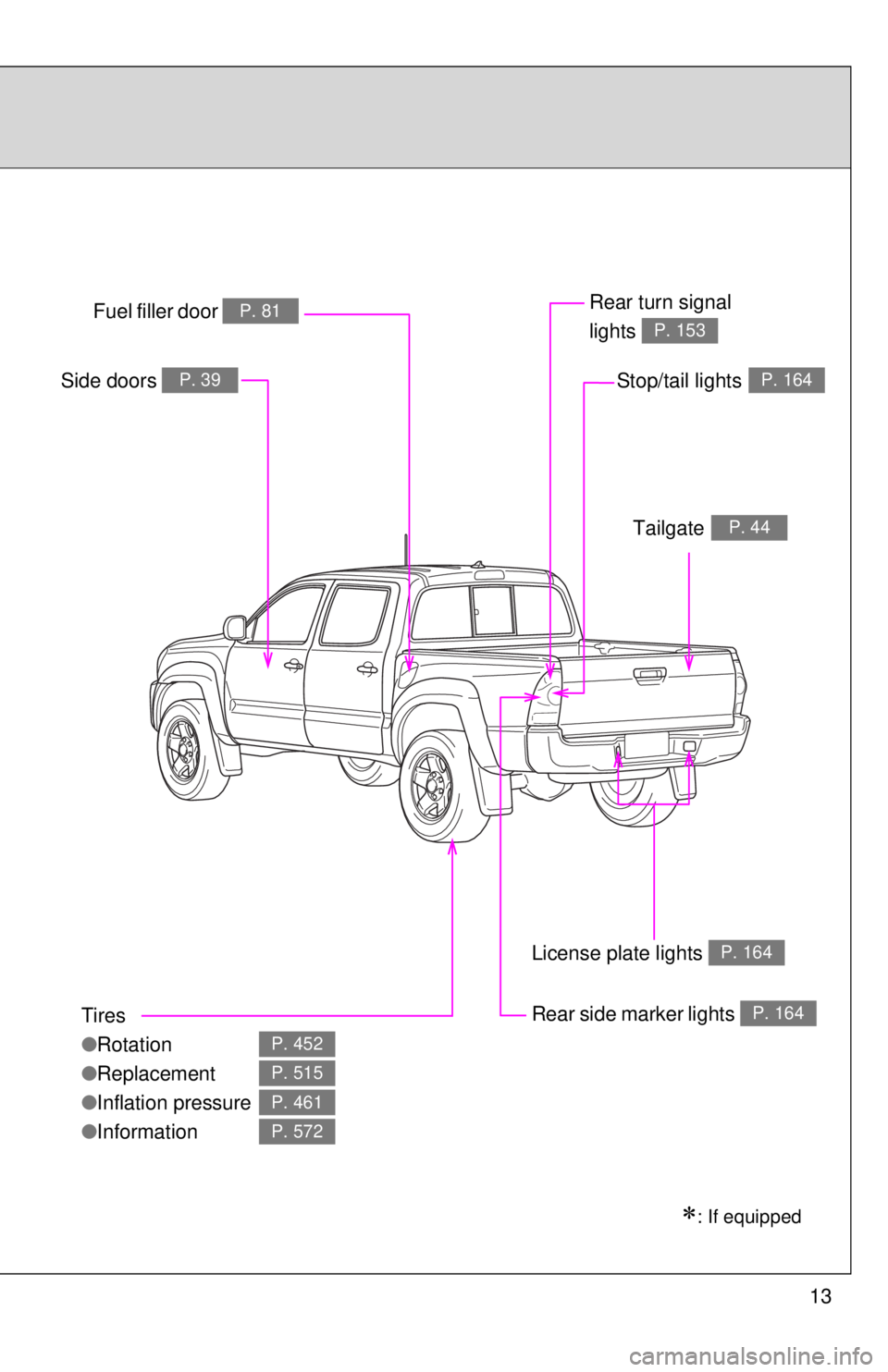
13
Tires
●Rotation
● Replacement
● Inflation pressure
● Information
P. 452
P. 515
P. 461
P. 572
Fuel filler door P. 81Rear turn signal
lights
P. 153
Rear side marker lightsP. 164
Side doors P. 39
: If equipped
Stop/tail lightsP. 164
TailgateP. 44
License plate lights P. 164
Page 417 of 628
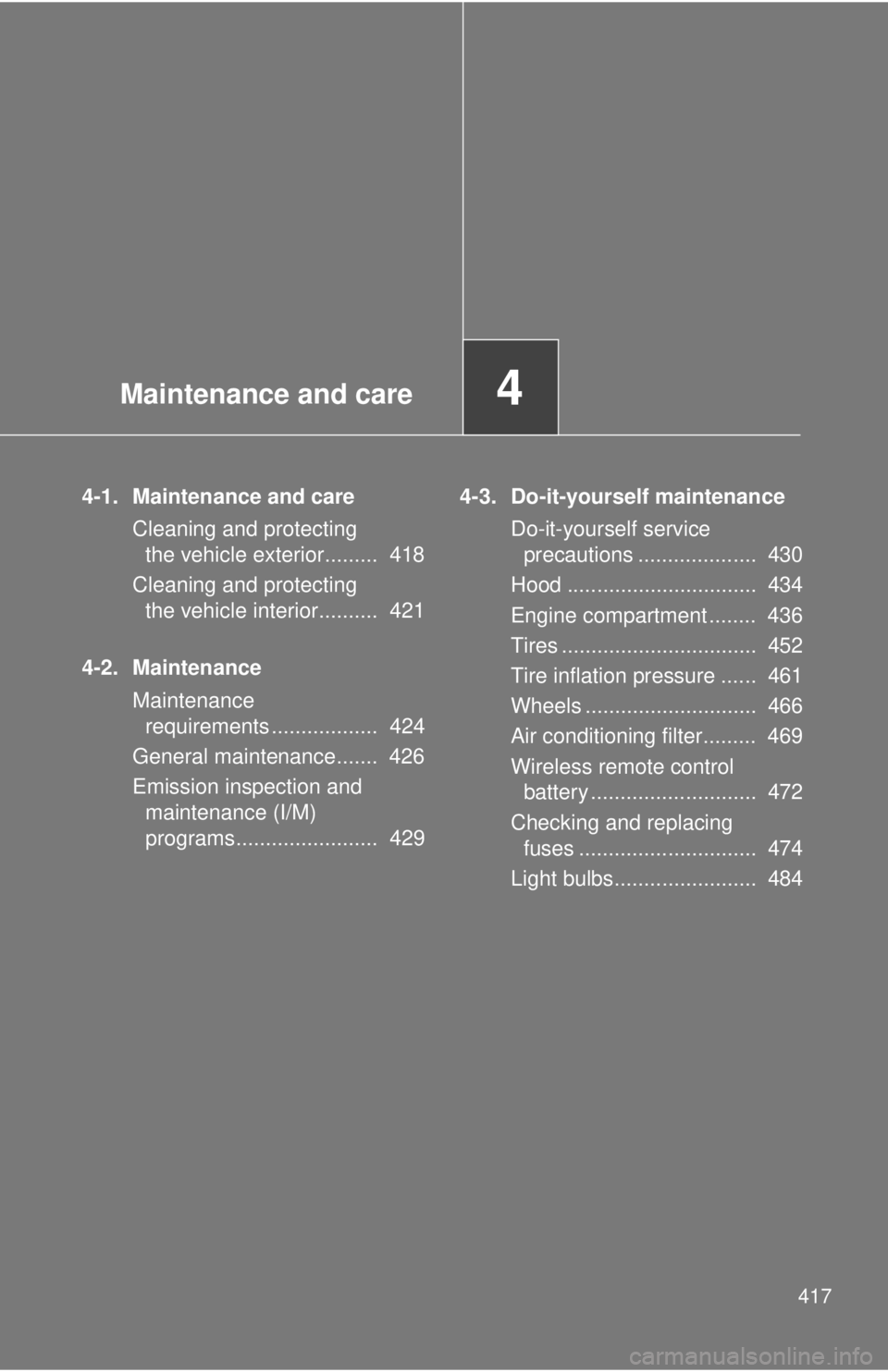
Maintenance and care4
417
4-1. Maintenance and careCleaning and protecting the vehicle exterior......... 418
Cleaning and protecting the vehicle interior.......... 421
4-2. Maintenance Maintenance requirements .................. 424
General maintenance....... 426
Emission inspection and maintenance (I/M)
programs........................ 429 4-3. Do-it-yourself maintenance
Do-it-yourself service precautions .................... 430
Hood ................................ 434
Engine compartment ........ 436
Tires ................................. 452
Tire inflation pressure ...... 461
Wheels ............................. 466
Air conditioning filter......... 469
Wireless remote control battery ............................ 472
Checking and replacing fuses .............................. 474
Light bulbs........................ 484
Page 428 of 628
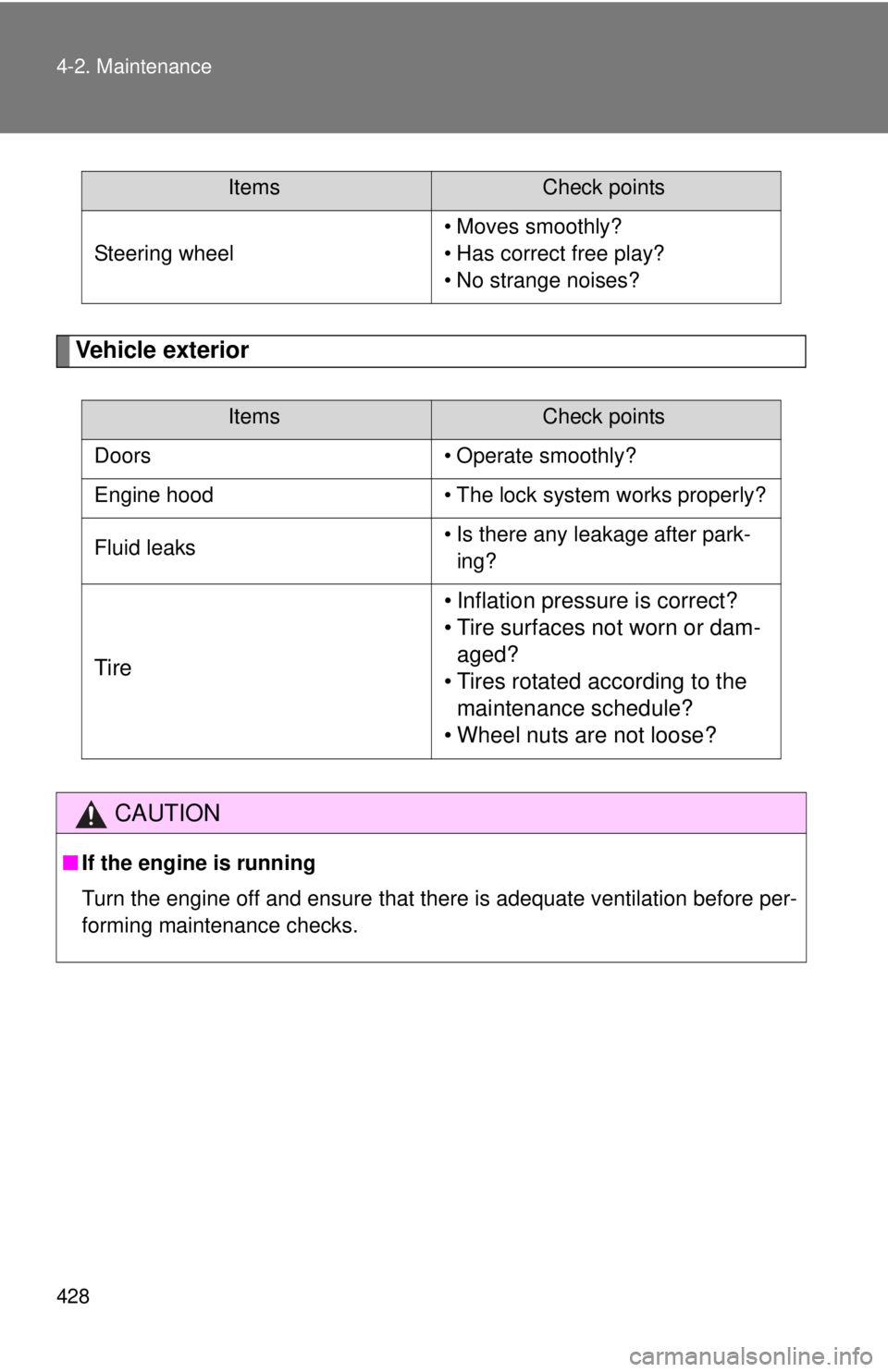
428 4-2. Maintenance
Vehicle exterior
Steering wheel• Moves smoothly?
• Has correct free play?
• No strange noises?
ItemsCheck points
Doors • Operate smoothly?
Engine hood • The lock system works properly?
Fluid leaks • Is there any leakage after park-
ing?
Tire • Inflation pressure is correct?
• Tire surfaces not worn or dam-
aged?
• Tires rotated according to the maintenance schedule?
• Wheel nuts are not loose?
CAUTION
■ If the engine is running
Turn the engine off and ensure that there is adequate ventilation before per-
forming maintenance checks.
ItemsCheck points
Page 431 of 628
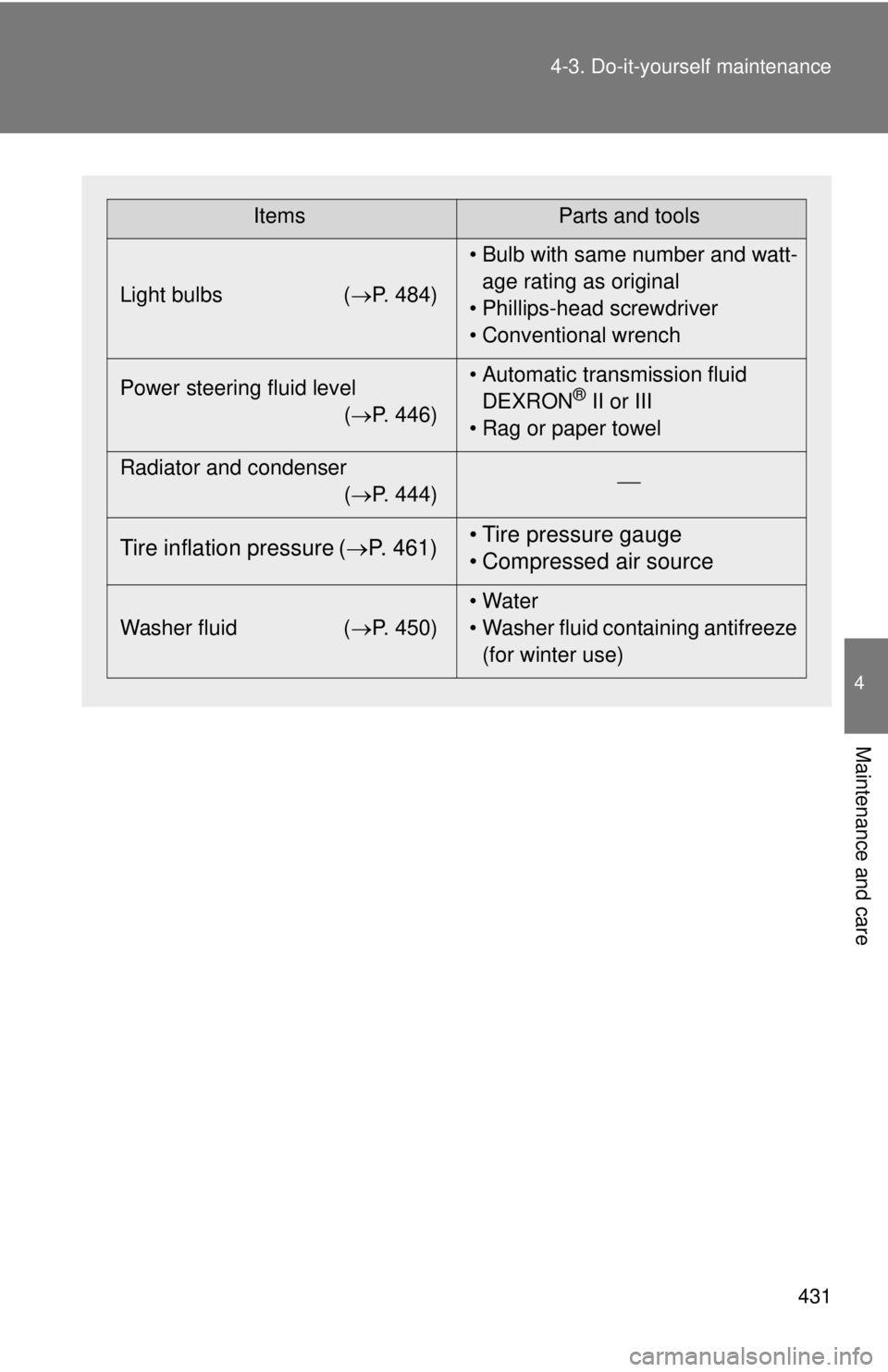
431
4-3. Do-it-yourself maintenance
4
Maintenance and care
ItemsParts and tools
Light bulbs ( P. 484)• Bulb with same number and watt-
age rating as original
• Phillips-head screwdriver
• Conventional wrench
Power steering fluid level (P. 446) • Automatic transmission fluid
DEXRON
® II or III
• Rag or paper towel
Radiator and condenser (P. 444)
Tire inflation pressure (
P. 461) • Tire pressure gauge
• Compressed air source
Washer fluid
(P. 450) • Water
• Washer fluid containing antifreeze
(for winter use)
Page 452 of 628
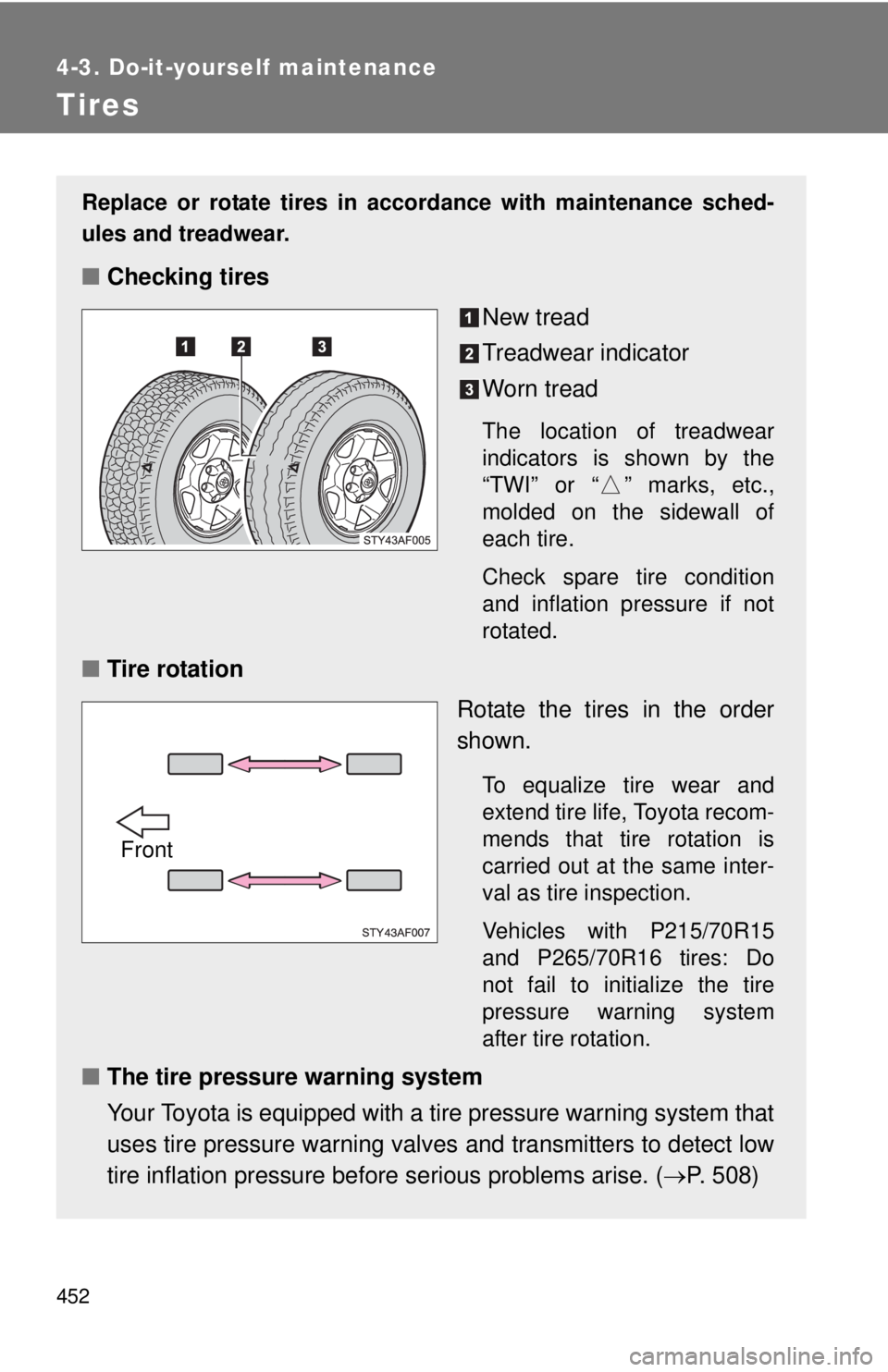
452
4-3. Do-it-yourself maintenance
Tires
Replace or rotate tires in accordance with maintenance sched-
ules and treadwear.
■Checking tires
New tread
Treadwear indicator
Worn tread
The location of treadwear
indicators is shown by the
“TWI” or “ ” marks, etc.,
molded on the sidewall of
each tire.
Check spare tire condition
and inflation pressure if not
rotated.
■Tire rotation
Rotate the tires in the order
shown.
To equalize tire wear and
extend tire life, Toyota recom-
mends that tire rotation is
carried out at the same inter-
val as tire inspection.
Vehicles with P215/70R15
and P265/70R16 tires: Do
not fail to initialize the tire
pressure warning system
after tire rotation.
■The tire pressure warning system
Your Toyota is equipped with a tire pressure warning system that
uses tire pressure warning valves and transmitters to detect low
tire inflation pressure before serious problems arise. (P. 508)
Front
Page 453 of 628

453
4-3. Do-it-yourself maintenance
4
Maintenance and care
Installing tire pressure warning valves and transmitters
When replacing tires or wheels, tire pressure warning valves and
transmitters must also be installed.
When new tire pressure warning valves and transmitters are installed,
new tire pressure warning valve and transmitter ID codes must be regis-
tered in the tire pressure warning computer and tire pressure warning
system must be initialized. Have tire pressure warning valve and trans-
mitter ID codes registered by your Toyota dealer. ( P. 454)
Initializing the tire pressure warning system
■ The tire pressure warning system must be initialized in the fol-
lowing circumstances:
●Vehicles with P215/70R15 and P265/70R16 tires: When rotating
the tires on vehicles differing with front and rear tire inflation
pressures.
● When changing the tire inflation pressure by changing traveling
speed or load weight, etc.
● When changing the tire size.
When the tire pressure warning system is initialized, the current
tire inflation pressure is set as the pressure benchmark.
■ How to initialize the tire pressure warning system
Park the vehicle in safe plac e and turn the engine switch to
the LOCK position.
While the vehicle is moving, in itialization is not performed.
Adjust the tire inflation pressure to the specified cold tire infla-
tion pressure level. ( P. 564)
Make sure to adjust the tire pressure to the specified cold tire
inflation pressure level. The ti re pressure warning system will
operate based on this pressure
level.
Turn the engine switch to the ON position.
Page 455 of 628
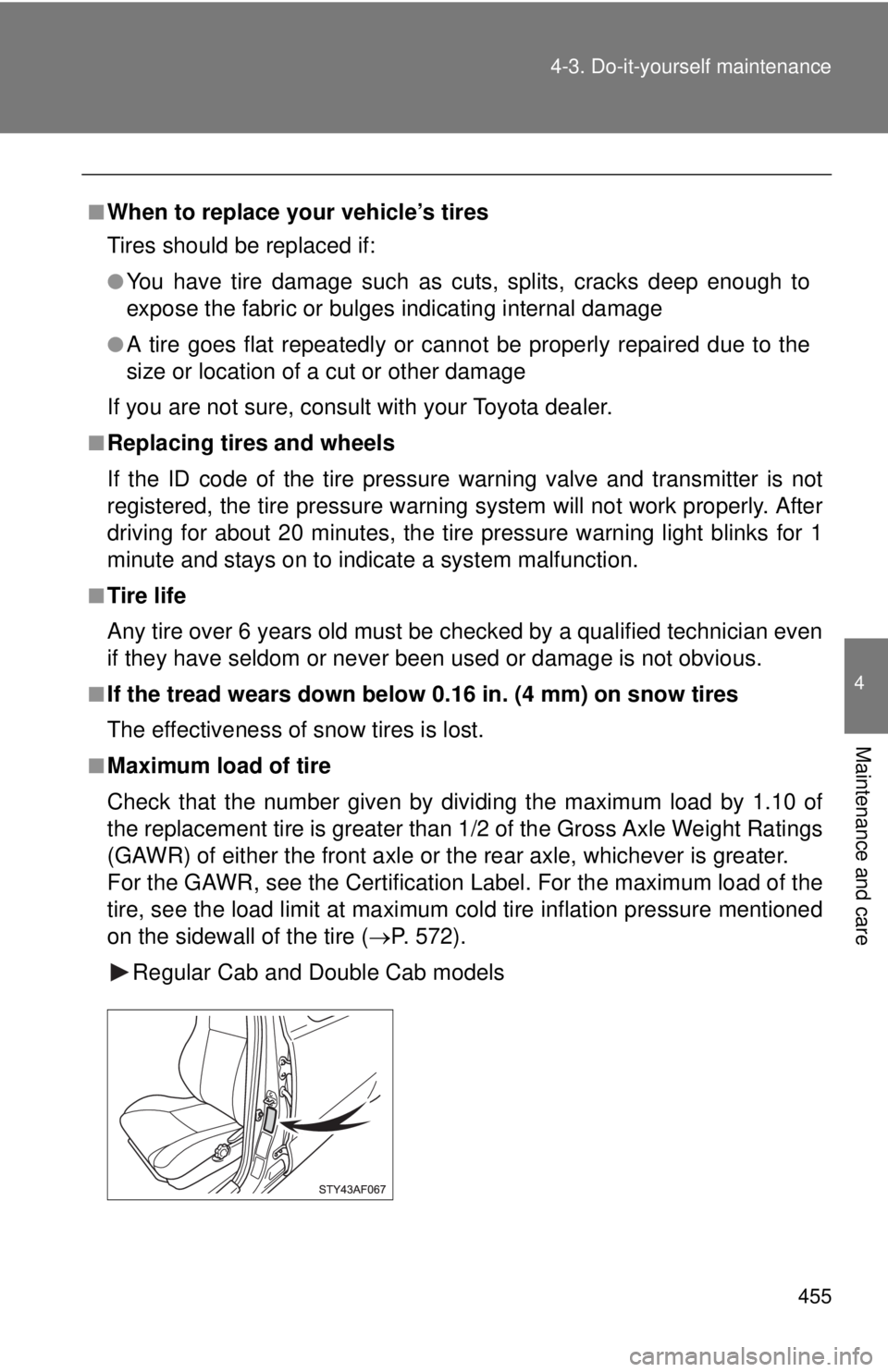
455
4-3. Do-it-yourself maintenance
4
Maintenance and care
■When to replace your vehicle’s tires
Tires should be replaced if:
●You have tire damage such as cuts, splits, cracks deep enough to
expose the fabric or bulges indicating internal damage
●A tire goes flat repeatedly or c
annot be properly repaired due to the
size or location of a cut or other damage
If you are not sure, consult with your Toyota dealer.
■Replacing tires and wheels
If the ID code of the tire pressure warning valve and transmitter is not
registered, the tire pre ssure warning system will not work properly. After
driving for about 20 minutes, the tire pressure warning light blinks for 1
minute and stays on to indicate a system malfunction.
■Tire life
Any tire over 6 years old must be checked by a qualified technician even
if they have seldom or never been used or damage is not obvious.
■If the tread wears down below 0.16 in. (4 mm) on snow tires
The effectiveness of snow tires is lost.
■Maximum load of tire
Check that the number given by divi ding the maximum load by 1.10 of
the replacement tire is greater than 1/2 of the Gross Axle Weight Ratings
(GAWR) of either the front axle or the rear axle, whichever is greater.
For the GAWR, see the Ce rtification Label. For the maximum load of the
tire, see the load limit at maximum co ld tire inflation pressure mentioned
on the sidewall of the tire ( P. 572).
Regular Cab and Double Cab models